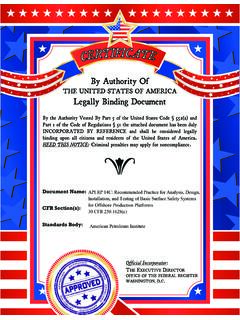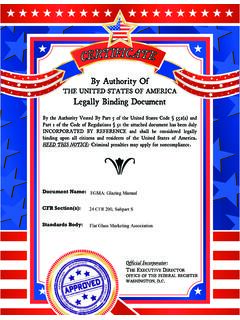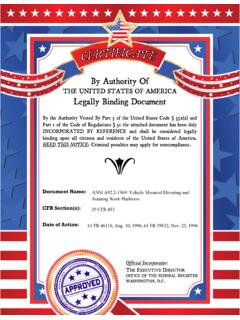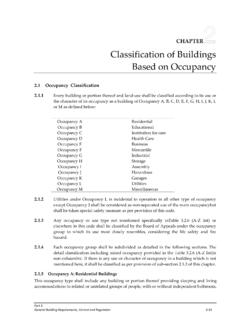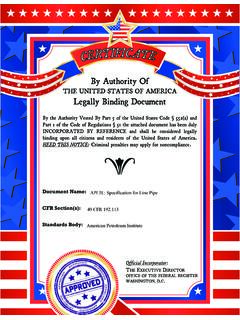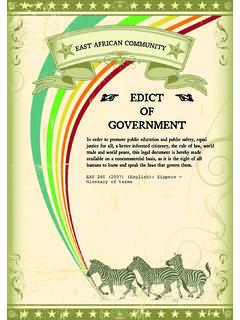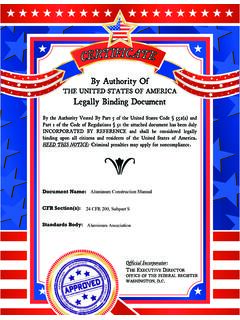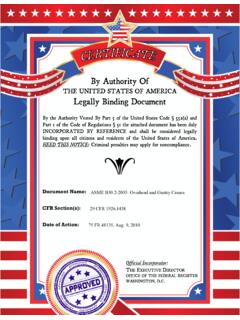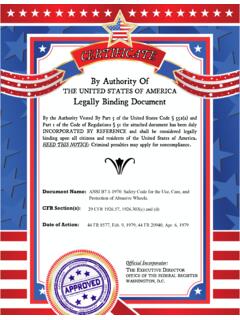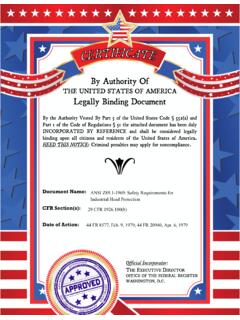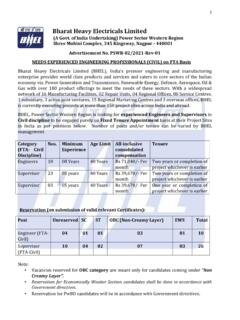Transcription of IS 1893 (1984): Criteria for earthquake resistant design ...
1 Disclosure to Promote the Right To InformationWhereas the Parliament of India has set out to provide a practical regime of right to information for citizens to secure access to information under the control of public authorities, in order to promote transparency and accountability in the working of every public authority, and whereas the attached publication of the Bureau of Indian Standards is of particular interest to the public, particularly disadvantaged communities and those engaged in the pursuit of education and knowledge, the attached public safety standard is made available to promote the timely dissemination of this information in an accurate manner to the public. ! $ ' + - Satyanarayan Gangaram Pitroda Invent a New India Using Knowledge 0 1 ' 5 Jawaharlal Nehru Step Out From the Old to the New 1 + , 1 + Mazdoor Kisan Shakti Sangathan The Right to Information, The Right to Live ! > 0 B Bhart hari N ti atakam Knowledge is such a treasure which cannot be stolen Invent a New India Using Knowledge IS 1893 (1984): Criteria for earthquake resistant design ofstructures [CED 39: earthquake Engineering]IS:1893-1984 lndian Standard Criteria FOR earthquake resistant design OF STRUCTURES (Fourth Revision ) First Reprint JULY 1999 UDC : 0 Copyright 1986 BUREAU OF INDIAN STANDARDS MANAK BHAVAN, 9 BAHADUR SHAH ZAFAR MARG NEW DELHI 110002 Gr 14 June 1986 IS t 1893 - 1984 Indian Standard CRITERlA FOR earthquake resistant design OF STRUCTURES ( Fourth Revision ) earthquake Engineering Sectional Committee, BDC 39 Chairman DR JAI KRISHNA 61 Civil Lines, Roorkee M# Rcprssenting SHRI A.
2 ANANTHAKRISRNAN Ministry of Shipping and Transport ( Develop- ment Wing j _ SRRI T. R. SUBRAM~NYAM ( Alternate) DR A. S. ARYA University of Roorkee, Roorkee DR A. R. CHANDRASEKARAN ( Alternate I ) DR BRIJESH CHANDRA ( Alternate II ) SHRI S. P. CHAKRABORTI Ministry of Shipping and Transport ( Roads SHRI M. K. MUKHE~JEF: ( Alternate ) Wing ) SIIRI T. A. E. D SA Concrete Association of India, Bombay SHRI N. Cl. DU~UAL ( Alternate ) DIRECTOR SHRI J. G. PADALE ( Alternate ) SERI D. S. DESAI SERI V. S. GOWAIKAR SHRI R. PATNAIK ( Alternate ) SHRI A. D. GUPTA SHRI N. S. DANI ( Alternate) SHRI INDER MOHAN SHRI C. VASWANI ( Alternate ) JOINT DIRECTOR STANDARDS ( B & S ) PSC DEPUTY DIRECTOR STANDARDS ( B & S ) CB ( Alternate ) SHRI M. Z. KURIAN Tata, Consulting Engineers, Rombay SHRI K. V. SUBRAMANIAN ( Alternate ) SHRI T. K. D. MUNSI SHRI R. K. GROVER (Alternate ) Engineers India Limited, New Delhi ( Continued on page 2 ) Central Water and Power Research Station, Pune M. N. Dastur & Co Pvt Ltd, Calcutta Department of Atomic Energy, Bombay Fertilizer Corporation of India Ltdi Dhanbad North Eastern Council, Shillong Railway Board (RDSO), Lucknow @ Copyright 1966 INDIAN STANDARDS INSTITUTION This publication is protected under the Indian Copyright Act ( XIV of 1957 ) and reproduction in whole or in part by any means except with written permission of the publisher shall be deemed to be an infringement of copyright under the said Act.)
3 ( Continued from page Members SERI C. RAMA RAO 1) REpresEnting Public Works Department, Government of Arunacbal Pradesh SHRI S. N. KRISRNAN ( Alfernate) SERI R. V. CR_~LAPATHI RAO Geological Survey of India, Calcutta SHRI N. B. G. TILA~ ( Alternnte ) R~PRERENYATIVE International Airport Authority of India, New Delhi REPRESENTATIVE Structural Engineering Research Centre, Roorkee REPRESENTATIVE bharat heavy Electricals Ltd (Research and design Division ), Hyderabad REPRESENTATIVE Central Building Research Institute, Roorkee SHRI ht. P. v. SHENOY Engineer-in-Chief s Branch, Army Headquarters New Delhi IS : 1893 - 1984 SHRI D. K. DINKER ( Alternate ) SHRI K. S. SRINIVASAN National Buildings Organization, New Delhi Dn H. N. SRIVASTAVA India Meteorological Department, New Delhi SHRI S. K. NAQ ( Alternate ) DR P. SRINIVASULU Structural Engineering Research Centre, Madras Dn N. LAKSHMANAN ( Alternate ) Dn A. N. TANDON SHRI N. VE~XBU SHI~I A. K. MITTAL ( Alternote ) SRI~I S. N. VERMA SHRI S.
4 PASUPATI ( Allernalc) SHRI G. RAMAN, Director ( Civ Engg ) In personal capacity ( B-7150 Safdarjung Enclave, flew Delhi ) Central Public Works Department, New Delhi Metallurgical & Engineering Consultants ( India ) Ltd, Ranchi Director General, ISI ( Ex-ojicio Member) Secretary SERI N. Cl. BANDYOPADHYAY Deputy Director ( Civ Engg ), IS1 Maps Subcommittee, BDC 39 : 4 DR S. N. BHATTACHAZ~YA SHRI A. N. DATTA SHRI A. GHOSH SHRI D. R. NANDY ( Alternate ) DR HARI NARAIN DR K. L. KAILA ( Allcrnate ) SHRI G. S. OBEROI India Meteorological Department, New Delhi Oil and Natural Gas Commission, Dehra Dun Geological Survey of India, Calcutta National Geophysical Research Institute (CSIR ), Hyderabad Survey of India, Dehra Dun ) SHRI K. N. SAXENA ( AltErnate , Dn P. C. SAXENA Central Water and Power Research Station, Pune SEIRI I. D. GUPTA ( Alternate ) SERI L. S. SRIVASTA~A University of Roorkee, Roorkee DR A. N. TANDON In personal capacity ( B-7150 Safdarjung Enclave, New Delhi ) 2 IS:1893 - 1984 Indian Standard Criteria FOR earthquake resistant design OF STRUCTURES ( Fourth Revision ) 0.
5 FOREWORD This Indian Standard. ( Fourth Revision) was adopted by the Indian Standards Institution on 16 November 1981, after the draft finalized by the earthquake Engineering Sectional Committee had been approved by the Civil Engineering Division Council. Himalayan-Nagalushai region, Indo-Gangetic plain, Western India, Kutch and Kathiawar regions are geologically unstable parts of the coun- try and some devastating earthquakes of the world have occurred there. A major part of the peninsular India has also been visited by strong earth- quakes, but these were relatively few in number and had considerably lesser intensity. The earthquake resistant design of structures taking into account seismic data from studies of these Indian earthquakes has become very essential,. particularly in view of the heavy construction programme at present all over the country. It is to serve this purpose that IS : 1893-1962 Recommendations for earthquake resistant design of structures was pub- lished and subsequently revised in 1966.
6 As a result of additional seismic data collected in India and further knowledge and experience gained since the publication of the first revision of this standard, the Sectional Committee felt the need to revise the stan- dard again incorporating many changes, such as revision of maps showing seismic zones and epicentres, adding a more rational approach for design of buildings and substructure of bridges, etc. These were covered in the second revision of IS : 1893 brought out in 1970. As a result of the increased use of the standard, considerable amount of suggestions were received for modifying some of the provisions of the standard and, therefore, third revision of the standard was brought out in 1975. The following changes were incorporated in the third revision: 3 IS: 1893 - 1984 a> b) 4 4 e> The standard incorporated seismic zone factors ( previously given as multiplying factors in the second revision ) on a more rational basis. Importance factors were introduced to account for the varying degrees of importance for various structures.
7 In the clauses for design of multi-storeyed building the coefficient of flexibility was given in the form of a curve with respect to period of buildings. A more rational formula was used to combine modal shears. New clauses were introduced for determination of hydrodynamic pressures in elevated tanks. f) Clauses on concrete and masonry dams were modified, taking into account their dynamic behaviour during earthquakes. Simplified formulae for design forces were introduced based on results of extensive studies carried out since second revision of the standard was published. The fourth revision has been prepared to modify some of the provi- sions of the standard as a result of experience gained with the use of this standard. In this revision a number of Important basic modifications with respect to load factors, field values of N, base shear and modal analysis have been introduced. A new concept of performance factor depending on the structural framing system and brittleness or ductility of construction has been incorporated.
8 Figure 2 for average acceleration spectra has also been modified and a curve for zero percent damping has been incorporated. It is not intended in this standard to lay down regulations so that no structure shall suffer any damage during earthquake of all magnitudes. It has been endeavoured to ensure that, as far as possible, structures are able to respond, without structural damage to shocks of moderate intensities and without total collapse to shocks of heavy intensities. While this stan- dard is intended for earthquake resistant design of normal structures, it has to be emphasized that in the case of special structures detailed investigation should be undertaken, unless otherwise specified in the relevant clauses. Though the basis for the design of different types of structures is covered in this standard, it is not implied that detailed dynamic analysis should be made in every case. There might be cases of less importance and relatively small structures for which no analysis need be made, provided certain simple precautions are taken in the construction.
9 For example, suitably proportioned diagonal bracings in the vertical panels of steel and concrete structures add to the resistance of frames to withstand earthquake forces. Similarly in highly seismic areas, construction of a type which IS : 1893 - 1984 entails heavy debris and consequent loss of life and property, such as masonry, particularly mud masonry and rubble masonry, should be avoi- ded in preference to construction of a type which is known to withstand seismic eflects better, such as construction in light weight materials and well braced timber-framed structures. For guidance on piecautions to be observed in the construction of buildings, reference may be made to IS : 4326-1976*. Attention is particularly drawn to the fact that the intensity of shock due to an earthquake could greatly vary locally at any ~given place due to variation in the soil conditions. earthquake forces would be affected by different types of foundation system in addition to variation of ground motion due to various types of soils.
10 Considering the effects in a gross man- ner, the standard gives guidelines for arriving at design seismic coefficients based on type of soil and foundation system. Earthquakes can cause damage not only on account of the shaking which results from them but also due to other chain effects like landslides, floods, fires and disruption to communication. It is, therefore, important to take necessary precautions in the design of structures so that they are safe against such secondary effects also. It is important to note that the seismic coeficient, used in ihe design of any structure, is dependent on many variable factors and it is an extre- mely dificult task to determine the exact seismic coefficient in each given case. Tt is, therefore, necessary to indicate broadly the seismic coeficients that could generally be adopted in different parts or zones or the country though, of course, a rigorous analysis considering all the factors involved has got to be made in the case of all important projects in order to arrive at suitable seismic coefficients for design .
